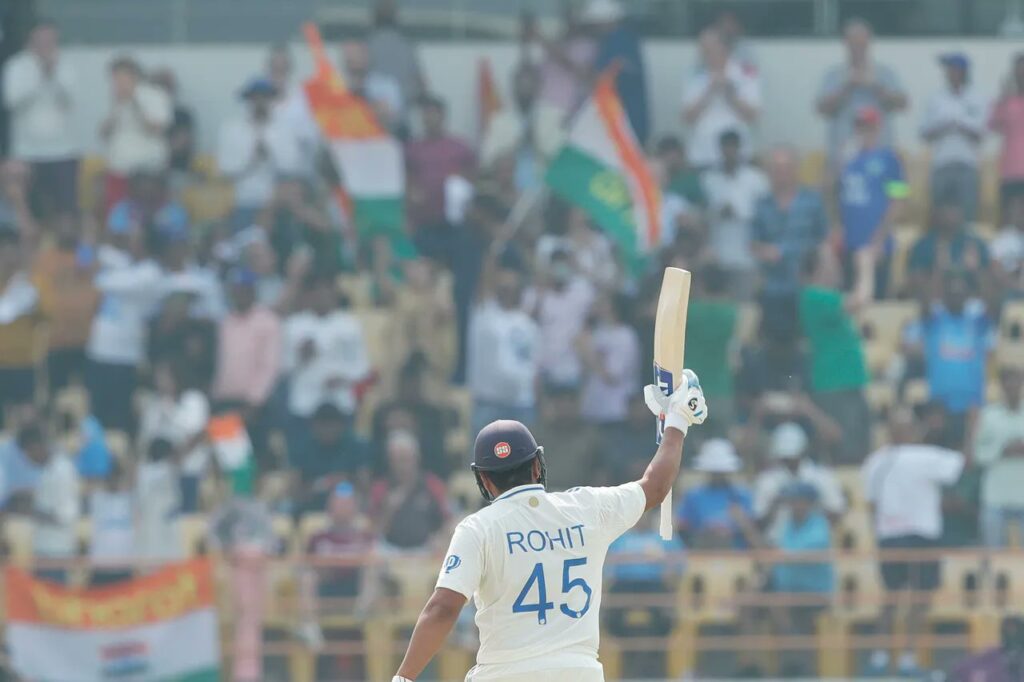
When Rohit Sharma walked out to mark his guard in a Test match for the first time – November 7, 2013, at the Eden Gardens in Kolkata – India were in a spot of bother at 82-4, in response to a modest West Indies total of 234. When Virat Kohli fell 11 balls later, it was 83-5. But with MS Dhoni (42) and R Ashwin (124) for company, Rohit stroked his way to a magnificent 177, as India ultimately won Sachin Tendulkar’s penultimate Test by an innings.
That too was a new-look line-up. Shikhar Dhawan was playing his second Test. Virat Kohli (18), Murali Vijay (16) and Cheteshwar Pujara (13) all had less than 20 caps. With Tendulkar having announced his swansong, it was very much a new era. Rohit, unfortunate not to make his debut against South Africa in Nagpur nearly four years earlier, was then viewed as the newest addition to a middle order that had already bid goodbye to Sourav Ganguly, Rahul Dravid and VVS Laxman.
In the decade since, eight of his 11 Test hundreds have come while opening the batting. And with Sarfaraz Khan, fellow Mumbai batter, getting his first cap in Rajkot, the wheel had very much come full circle for Rohit. In his 57th Test, he is very much the senior statesman. Ravindra Jadeja, playing his 70th Test, may have been promoted to No. 5 after the collapse in the first hour, but it would have escaped no one’s attention that nobody else among the specialist batters had even 25 caps. And no matter how much first-class cricket you’ve played, Tests are an entirely different ball game.
In that context, this was one of Rohit’s most important knocks. His record in Indian conditions is peerless – this was his ninth century at home in 27 Tests, while averaging in the region of 65 – and you could see from how unflustered he was that he trusted his technique, whether that was against Jimmy Anderson, or the awkward trajectory of Tom Hartley’s left-arm spin.
Both Rohit and Jadeja also knew that what happened in the first hour was nothing out of the ordinary for an Indian pitch in winter. There will be some movement off the seam early on, and some sharp turn, but once the pitch loses its freshness, it usually settles down to be a belter. Rohit waited for that, while putting away the loose balls.
The flicks through midwicket come almost by default for those raised on Mumbai’s maidans, and he supplemented those with a couple of stunning drives off the back foot. Each time the spinners threatened to settle into a length, a big hit would have them questioning their methods. It was the perfect template for how to bat in India, and we hadn’t seen enough of it from Indian batters in this series.
He would also doubtless have had inputs into Jadeja’s promotion ahead of Sarfaraz. The right-left combination didn’t allow England’s callow attack – minus Anderson – to settle, and Jadeja’s intimate knowledge of these conditions played a big part in what was a potentially game-turning 204-run stand.
It will irk Rohit no end that he fell into a trap that had been set for him, but by then, Sarfaraz had been given a platform to build on. It now remains to be seen whether he can go on and do what Rohit did over a decade ago.




